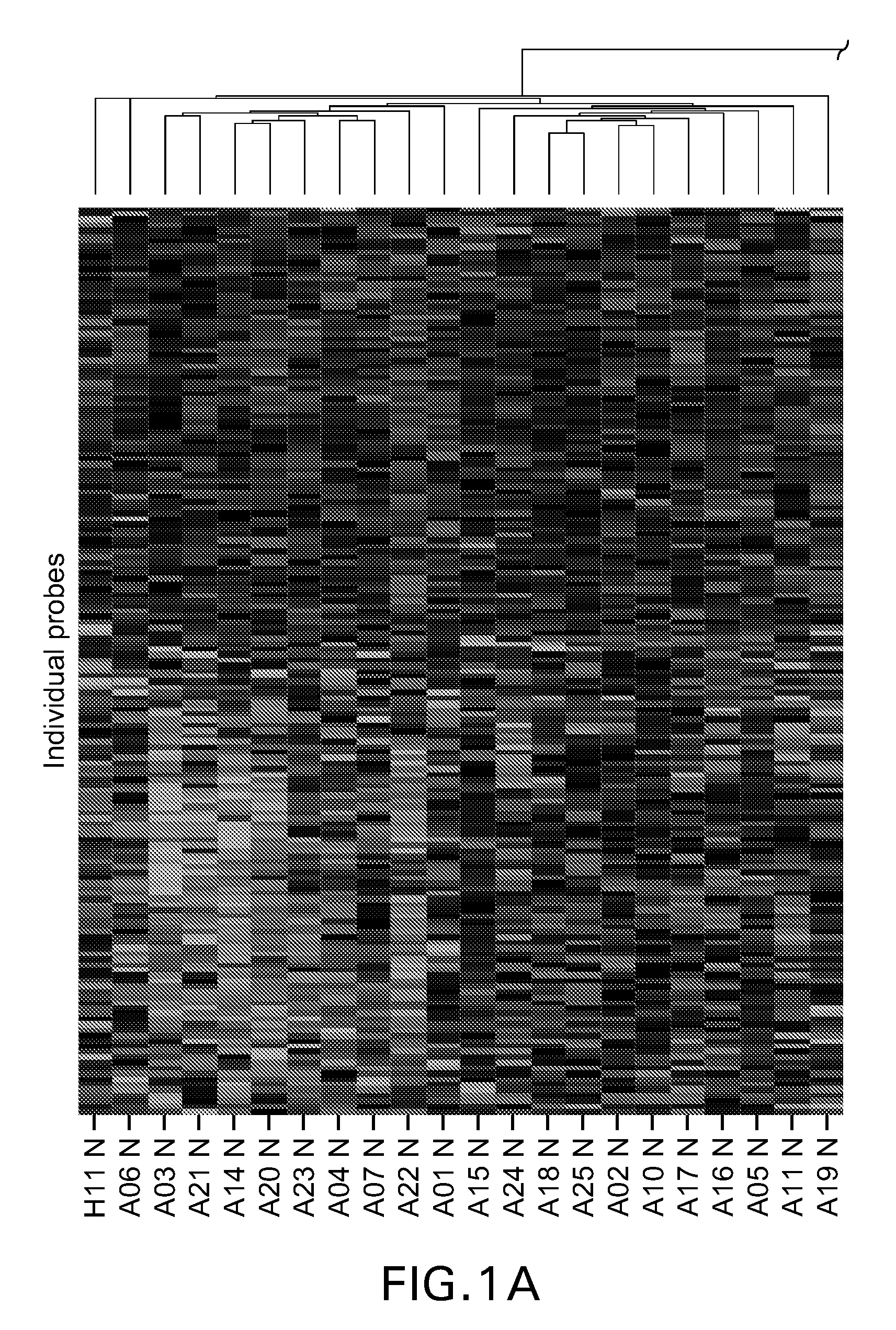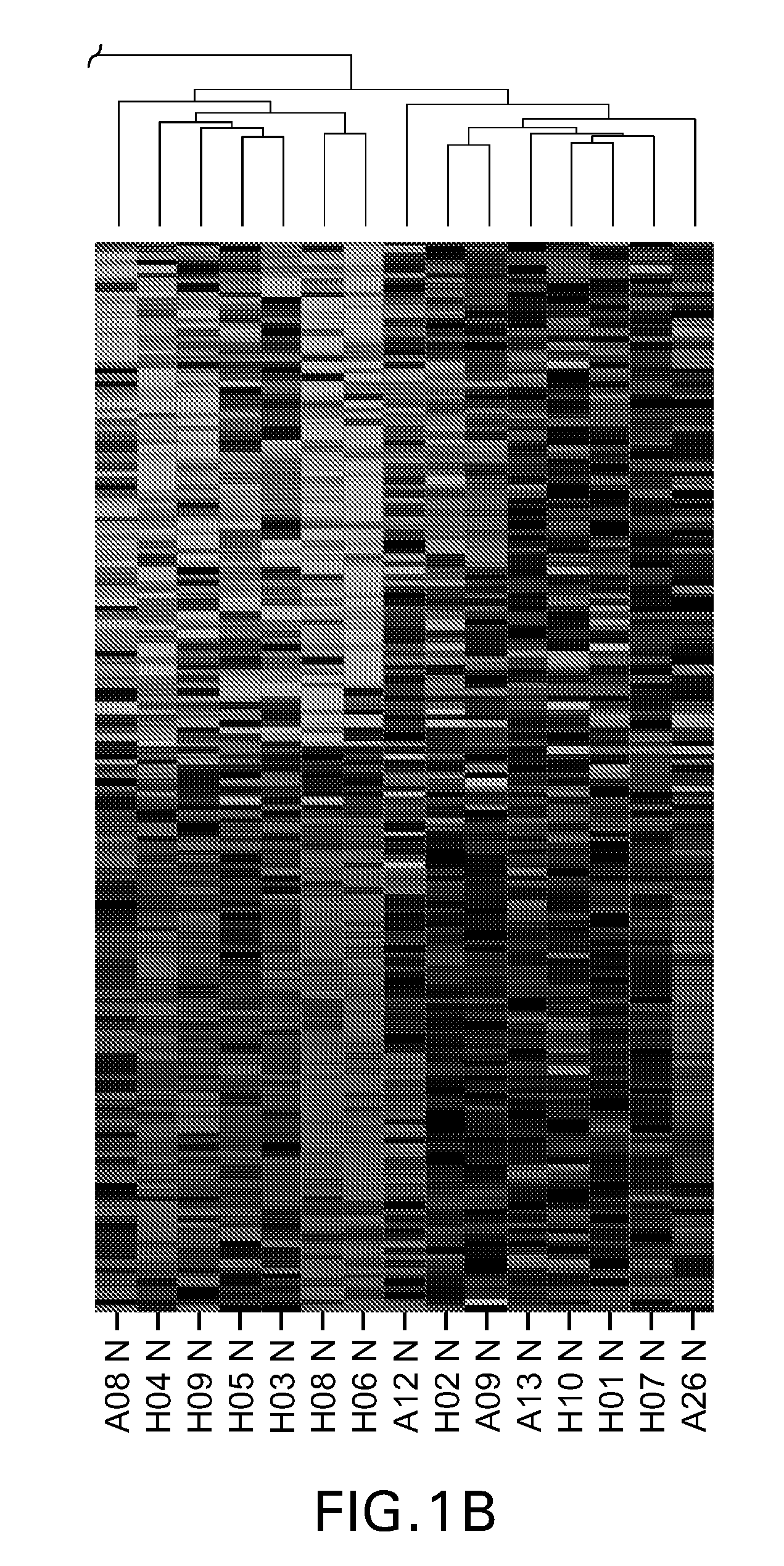Assessment of asthma and allergen-dependent gene expression
a technology of asthma and gene expression, applied in the field of asthma markers, can solve the problems of asthma-associated biological responses that can become life-threatening or fatal, shortening the duration of the treatment, wheezing, coughing, etc., and achieve the effect of assessing the effectiveness of the treatment in blocking, dampening or mitigating the biological response of asthma
- Summary
- Abstract
- Description
- Claims
- Application Information
AI Technical Summary
Benefits of technology
Problems solved by technology
Method used
Image
Examples
example 1
Clinical Trial and Data Collection
Demographics of Subjects
[0205]Twenty-six (26) subjects with asthma and eleven (11) healthy volunteer subjects were recruited for this study. Asthma subjects were from the Allergy, Asthma and Dermatology Research Center in Lake Oswego, Oreg. and Bensch Research Associates in Stockton, Calif. Healthy volunteers were from Wyeth Research in Cambridge, Mass. Each clinical site's institutional review board or ethics committee approved this study, and no study-specific procedures were performed before obtaining informed consent from each subject. All asthma subjects were on standard of care treatment of inhaled steroids, and samples collected included 4 (15%) from patients on systemic steroids. Asthma subjects were categorized as mild persistent, moderate persistent or severe persistent according to the 1997 NIH Guidelines for the Diagnosis and Management of Asthma. In all, 19 of the asthma subjects were allergic, with the remainder non-allergic. Atopic st...
example 2
Determination of Disease-Related Transcripts in Volunteers
In Vitro Histamine Release Occurs in Both Populations
[0216]An important aspect of the inflammatory response is the release of granules by leukocytes. In particular, histamine is released by basophils and mast cells in response to allergen. Whole blood samples obtained from healthy and asthmatic volunteers were treated with allergen for thirty minutes and histamine release was measured. Allergen induced histamine release was compared to histamine release in response to anti-human IgE. The antibody causes non-specific degranulation through the cross-linking of IgE present on the surface. Samples that had a positive response to IgE cross-linking were subsequently tested in a histamine release assay in response to allergen. In the healthy population, eight of the eleven tested positive in the control experiment and only one was responsive to allergen. In the asthmatic population, fifteen of twenty-six were positive in the control...
example 3
Transcriptional Effects of Therapy
[0220]cPLA2 Inhibitor Therapy Alters the Expression Profiles in Response to Allergen
[0221]The transcriptional effect of cPLA2 inhibition on expression of the 167 allergen-asthma specific probesets was determined. The asthma specific gene expression was altered in the presence of the inhibitor 4-{3-[1-benzhydryl-5-chloro-2-(2-{[(2,6-dimethylbenzyl)sulfonyl]amino}ethyl)-1H-indol-3-yl]propyl}benzoic acid (hereinafter “the cPLA2 inhibitor”) when compared to the allergen treatment alone. The complete analysis results, including fold changes, with and without cPLA2 inhibition is listed in Tables 7a and 7b. With the exception of a few probes, the probe set falls into two distinct categories. In the first category, probes that correspond to genes that were up-regulated in asthma samples in response to allergen, such as ZAP70, LCK, and MCM 2, are reduced to the levels seen in the allergen treated healthy controls. In the second category, genes that were init...
PUM
| Property | Measurement | Unit |
|---|---|---|
| temperature | aaaaa | aaaaa |
| vascular permeability | aaaaa | aaaaa |
| time | aaaaa | aaaaa |
Abstract
Description
Claims
Application Information
 Login to View More
Login to View More - R&D
- Intellectual Property
- Life Sciences
- Materials
- Tech Scout
- Unparalleled Data Quality
- Higher Quality Content
- 60% Fewer Hallucinations
Browse by: Latest US Patents, China's latest patents, Technical Efficacy Thesaurus, Application Domain, Technology Topic, Popular Technical Reports.
© 2025 PatSnap. All rights reserved.Legal|Privacy policy|Modern Slavery Act Transparency Statement|Sitemap|About US| Contact US: help@patsnap.com



